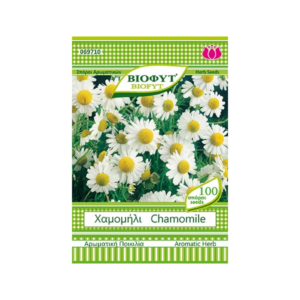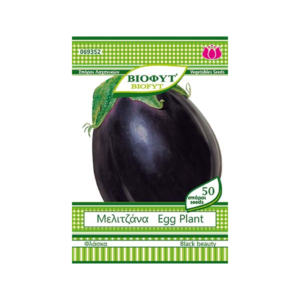Parsley Broadleaf
Parsley Broadleaf
Parsley is one of the most favorite herbs that we grow in the garden and also in a pot on our balcony. It stands out for its wonderfully aromatic leaves that we cut fresh to use in salads, in pies and in special cooking recipes. Although it is a biennial vegetable, parsley is usually grown as an annual plant. Parsley has a high nutritional value, as it has a high content of antioxidants and vitamins. Parsley needs fertile soil with good drainage and rich in nutrients, so we enrich the soil we have with compost, manure and organic fertilizer to improve its fertility. Parsley prefers cool weather, in sunny places with temperatures of 10-20°C. During the summer season, we should secure semi-shady places for the parsley, in order for it to have better growth and not to develop premature flowering shoots.
Parsley needs frequent watering in small amounts at a time, avoiding excess moisture that can cause the parsley leaves to turn brown and rot. So we water every 2-3 days during the spring and autumn, while in the summer we make sure to water more regularly. Watering the plants on hot summer days can be done daily to cope with the high temperatures that can also cause drying of the leaves.
More Products
Chamomile
ChamomileChamomile, the beautiful plant with its characteristic aroma and unique beneficial properties. Chamomile is a favorite herb found naturally in the Greek countryside and often picked to be enjoyed as a relaxing tea. All of us chamomile fans can grow it in the garden, as well as in a pot in our yard or balcony, to make wonderful drinks at home. Chamomile is a low-growing, low-maintenance herbaceous plant that is extremely easy to grow. In addition to the beneficial properties it has at our disposal and our health, chamomile also has a special decorative value due to the impressive numerous small flowers with white petals and a characteristic yellow color in the center of the flower that resemble small daisies. There are 2 main varieties of chamomile, the German or wild chamomile, an annual or biennial plant that is taller and the Roman or tame or garden chamomile that is shorter growing and perennial. Let’s see what care chamomile needs to grow it in the garden and in a pot on our balcony and to enjoy beautiful flowers and healthy drinks at home.
Eggplant Flask
Eggplant FlaskEggplant, the summer’s favorite vegetable! Eggplant is one of the main ingredients of the Mediterranean cuisine that we enjoy in unique summer recipes, from the world-famous moussaka, to the wonderful shoes and the Asia Minor imam baildi. Eggplant is a vegetable with high nutritional value that contains many antioxidants and vitamins. It is eaten mainly grilled, fried but also stewed. We avoid eating eggplant raw, because of its bitter taste, as well as the solanine, a toxic substance it contains when harvested prematurely.
The eggplant crop grows to a height of about 80-90 centimeters and usually does not need subtiling. Eggplant leaves have a smooth upper surface and are smooth while the underside is relatively fluffy. It is planted in the spring and forms characteristic purple flowers that give us the fruits in the summer.
There are many known varieties and hybrids of eggplant to grow. It is important to choose eggplant varieties from our own seed that we keep, so that we know the special characteristics of each variety and how it adapts to the conditions of our region. Among the traditional and local eggplant varieties, we distinguish the Lagada eggplant variety with its long, narrow purple fruits, the purple flask eggplant used in stuffed foods, as well as the teardrop eggplant with its characteristic shape. The two-colored Tsakonian eggplant with its white and purple stripes is also unique and particularly popular and does not taste bitter. Also, the Santorini eggplant is a very distinctive variety with impressive white round fruits and a delicious sweet taste that is not bitter.
Eggplant cultivation grows best in areas with a warm climate. It is worth mentioning that the eggplant needs more heat than the tomato crop and the pepper crop, as well as being much more sensitive to low temperatures and frost. Eggplant planting takes place from April onwards, when the temperature has risen noticeably. Eggplant grows in loose, fertile soils that have good drainage to remove excess water. When preparing the soil for cultivation and before planting the eggplant, we plow the garden and incorporate enough organic matter into the planting pits in the form of compost and digested manure, as well as complete organic fertilizer.
Fennel
FennelFennel belongs to the apiaceae family. The root is white and penetrates to a great depth and the shoot is upright, green and cylindrical. The main part of the plant is its lower part, which is the pseudobulb of the fennel and is basically a thickening of the leaves at their base. The flowers are small and the fruits are 5 mm in diameter, oblong with shades of green and light grey-brown.
Purslane
PurslanePurslane, also known as anthrakla, is an annual, native, multi-branched plant of the Mediterranean with characteristic smooth and fleshy shoots. Wormwood grows in cultivated fields and especially in vegetable gardens that are watered in late spring and bears small yellow flowers. Although often considered an unwanted grass (weed) in the garden, buttercup is edible, very tasty and has a high nutritional value.
Chicory
ChicoryWhat are the most popular radish varieties to grow? There are many species and varieties of radish to choose from and grow. First, the wild radish with its bitter taste and characteristic green jagged leaves that turn red at the base. Stamnagathi is also a variety of wild radish. And then there is the tame radish with the upright, wider leaves, lighter at the base and with less bitterness. Also, the Italian radish with its upright toothed leaves, spicy bitter taste and many harvests. Let’s not forget radicchio, the radish variety with crimson leaves and white nerves that close like lettuce leaves. Radizio has a strong spiciness when eaten raw that fades with cooking. Radish is a horticultural plant that loves the cold environment and that is why it is planted in the autumn season when we have low temperatures, humidity and few hours of daily sunshine. After all, at high temperatures, the radish blooms prematurely and is unsuitable for consumption. We plant radishes in sunny or semi-shady places and we prefer rich, fertile and cool soils that ensure good drainage. If we plant in the ground, we incorporate organic matter in the form of compost and digested manure for better root development. To plant it in a pot, we use potting soil special for horticulture, rich in organic matter and nutrients, and place the pot on a balcony with western or eastern exposure for the radish culture to thrive.
Cucumber mini
Cucumber miniThere are dozens of cucumber varieties and hybrids that are commercially available and that we can plant. Depending on the size of the fruit, the cucumber varieties are divided into the large-fruited varieties and the small-fruited varieties that, in addition to being fresh, are also used for pickling. A traditional long-fruited variety of cucumber is the Kalybiotiko cucumber, suitable for summer outdoor cultivation that gives very tasty smooth dark green fruits, about 40 cm long. Among the small-fruited varieties, we distinguish the Knossos variety, from the Heraklion region of Crete, with a smooth, dark green, crunchy fruit about 20 centimeters long. Long cucumber, a traditional variety of cucumber.









